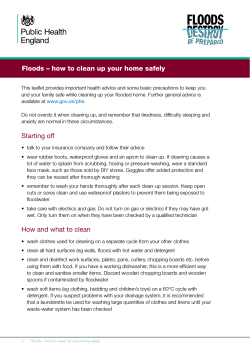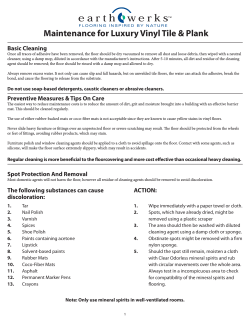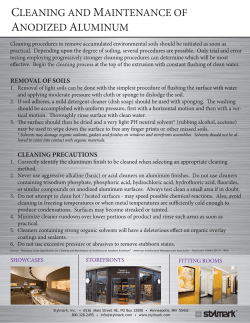
“DIDGERIDOO HYGIENE - How to clean and sanitize your didgeridoo”
Jack Azzarà Didgeridoo Player http://www.jackazzara.eu “DIDGERIDOO HYGIENE - How to clean and sanitize your didgeridoo” One of the most debated issues among didgeridoo players, and one of the questions most frequently asked by beginners and non-didgeplayers alike, has to do with the didgeridoo's hygiene. I often happened to notice on the face of those seeing for the first time a specimen of 'singing tree' a disgusted look, at the mere idea of what might have become of the inside of the instrument after an intense playing session. Therefore, I decided to write this article in order to share my personal experience and knowledge about this matter. Of course, what you are going to read must not be interpreted as a dogma: thus, please feel free to experiment as you please. Just keep in mind not to use toxic products, harmful for your health, or products that could damage the material your instrument is made of. Before expounding on the matter, though, I want to clear up a point. The didgeridoo is a wind instrument, and as such it must be kept clean: therefore, refusing strangers to play your instrument is a most sacred right of yours, and not an act of misanthropy. I wrote this because, unfortunately, a misinterpretation of the didgeridoo's cultural background made it win the largely undeserved reputation of being the instrument of choice of pot-heads and dopers (so much that it is often mistaken for a huge chillum!). Therefore, if you don't let strangers play it, you run the risk of being considered not an easygoing fellow. This preliminary statement made, I'll go on illustrating a few ways and contrivances to keep your instrument clean and, if not sweet-smelling, at least not foulsmelling! Cleaning the inside of hemp, PVC, plastic, fibreglass, carbon fibre et al. didgeridoos Keeping clean and sweet-smelling didgeridoos made of so-called 'alternative' materials is quite easy. They can be washed with running water and hand or body soap. It is always wise to read the instructions written on the package of the product you choosed, but, for the sake of convenience and economy, I'd suggest to use products that don't produce too much foam and aren't too sophisticated (I mean, you're just cleaning a musical instrument, not getting ready for a date!). After washing the instrument and letting the water drain away, I suggest to dry it, in order to avoid moisture. Tie a cloth around a thin plastic pipe (tie it firmly, to prevent it from getting stuck inside the didgeridoo); then, insert the pipe in the instrument from the bell and move it up and down like a swab. Pagina 1 di 4 Jack Azzarà Didgeridoo Player http://www.jackazzara.eu Cleaning the inside of a wooden didgeridoo Cleaning and keeping clean wooden didgeridoos is a little more difficult, because many different kinds of wood are employed to build didgeridoos. Several players told me they washed their wooden didges with water and soap and had no problems whatsoever. Actually, I washed my willow tree wood didgeridoo with water and soap without damaging it. Anyway, although is undeniable that wooden didgeridoos can be washed as if they were made of 'alternative' materials, my suggestion is to be very cautious. In any case, in order to avoid unpleasant surprises, I suggest to contact your didgeridoo's builder and/or dealer and ask for information before washing it. To clean a wooden didgeridoo without using water and soap, I follow this method. 1) I soak a cloth in a liquid sanitizer. 2) I tie it firmly around a thin plastic pipe (to prevent it from getting stuck inside the didgeridoo) 3) I insert the pipe in the instrument from the bell and I slowly move it up and down like a swab for at least five minutes. 4) I pour a gill of water down the didgeridoo (from the mouthpiece toward the bell), in order to remove debris that might have come off. 5) After letting the water drain away, I repeat step 3. This done, I pour some cooked linseed-oil down the didgeridoo, from the mouthpiece toward the bell, at the same time rotating the instrument. The rotating motion will help the linseed-oil evenly spread inside the didgeridoo. As a matter of fact, the purpose of pouring linseed-oil down the didgeridoo is not sanitizing it, but lubricating the wood and keep it in a good condition. Moreover, I find the linseed-oil's scent quite pleasant, so I needn't use natural scented oils to perfume my instruments. Once you've poured the linseed-oil down your didge, you must let the oil drain away for at least a couple of days. Be sure to rest your didge upon a pile of old newspapers or Scottex paper towels, to prevent the oil from soiling the floor. Cleaning the mouthpiece Regardless the material my didgeridoos are made of, to clean the mouthpiece I employ the following method. I soak a small cloth in water and I run it inside the mouthpiece. Then, I clean the mouthpiece with a few Scottex paper towels, rolled up and soaked in a sanitizer: needless to say, the sanitizer must be non-toxic! You may use oral cavity sanitizers on sale at the chemist's or herbalist's. Personally, I use teatree oil (Melaleuca alternifolia), a sanitizer and fungicide substance that, by the way, has Australian Aboriginal origins http://www.erboristeria.eu/prodotti.php?art_cod=MELUKO Pagina 2 di 4 Jack Azzarà Didgeridoo Player http://www.jackazzara.eu Perfuming your instruments Once you've cleaned your instrument, you might find that it smells a bit funny. Or, maybe, you might not like the smell of the sanitizer employed or of the linseed-oil. Or, simply, you might want to perfume your instrument. To this purpose, you may use the natural scented oils usually on sale at the herbalist's. I tried lemon, bergamot (Citrus bergamia) and cinnamon oil; anyway, whatever the oil you choosed, pour it down your didge from the mouthpiece toward the bell. Make sure that the oil drops don't touch the rims of the mouthpiece: natural scented oils (that, in any case, should never be ingested) are usually very strong, and feeling them on your lips while you're playing might be not that pleasant. How often should you clean your instruments? There is no fixed rule. Supposing you play your didge at least three hours a week, I should say to wash your non-wooden instruments at least once a month. Personally, though, I prefer washing PVC instruments (like the Didjeribone©, for instance) after every rehearsal, because a thirty-minute playing session is enough to make them sticky and a bit foul-smelling. For what regards my wooden instruments, I sanitize them three or four times a year, when seasons change. What about cleaning the outside? Questions about if and how the outside of a didgeridoo should be cleaned are seldom asked. Actually, I must admit that my knowledge about this matter is quite scanty. Anyway, if your didgeridoo is made of an 'alternative' material and has no decorations whatsoever, you may clean its outside with running water. If it's made of wood, I'd suggest to contact its builder/dealer and ask for suggestions about what product should be used, according with the kind of wood the instrument is made of. However, I found out that softly running a damp Scottex paper towel over the didge's surface makes no harm at all. If your instrument (whatever material it's made of) is decorated, well, it is a whole another matter. Regardless the technique employed to decorate it, the variables are way too many: therefore, I prefer not to expound on this matter, but just to suggest you to contact the instrument's builder/dealer and inquiry about the technique employed to decorate it. Anyway, this is more a matter of maintenance than of cleanness or hygiene. Pagina 3 di 4 Jack Azzarà Didgeridoo Player http://www.jackazzara.eu What sequence should be followed to clean your instrument? To clean and sanitize my didgeridoos I usually follow this sequence: 1) Inside cleaning 2) Outside cleaning 3) Perfuming 4) Mouthpiece cleaning. You may invert the sequence, but always make sure the mouthpiece cleaning is the last step. Summing up, I remind you to read this article with a critical mind. Of course, suggestions and criticism (provided it's founded) alike will be well accepted. Jack Azzarà Jack.azzara@yahoo.it N.B Primarily published in Italian on the 'Yidaki News' paper magazine. Pagina 4 di 4
© Copyright 2025










